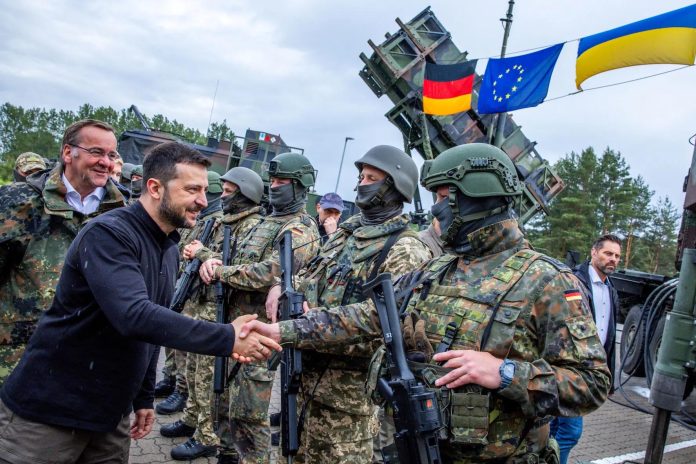
Dr. Syed Mehboob
Senior Business and Political Analyst
http//: www.thenewslark.com
Email:drmehboob.thenewslark@gmail.com
Western countries poured billions of dollars into military, financial, and logistical support to Ukraine, and fully backed it politically. European nations have notably increased their military industrial production to support Kyiv, while the USA remains a major donor. Till March 2025, the USA has provided approximately US$123 billion in total, with an average monthly US$3.2 million, average daily US$2.383 million. This includes military aid if US$69 billion. According to the Kiel Institute, this includes advanced weapon systems like HIMARS, Patriot air defence, and Abrams Tanks. In October 2025,the US Senate passed a defence budget that proposes US$500 million in new security assistance for Ukraine.
The European Union and its member states have provided 177.5 billion Euros in support, including 63.2 billion euros in military air and 93.6 billion in financial and humanitarian support. As of August 2025, 31.3 billion euros had been mobilized under the Ukraine facility. The European Union and G7 launched the “ Extraordinary Revenue Acceleration ( ERA) loan mechanism to provide Ukraine with euros 45 billion in loans, financed by profits from mobilized Russian assets. Since the beginning of the war, Europe has allocated more to military air via defence procurement, 35.1 billion euros, than the USA, signaling a shift from drawing on existing stockpiles towards industrial production.
Germany is Ukraine’s second-largest military aid provider overall and increased its bilateral military aid package to 5 billion in May 2025. Germany has also earmarked an additional 8.3 billion euros for military aid in its budget 2025. The United Kingdom has committed 13 billion pounds in military support and will sustain 3 billion pounds per year until at least 2030. Denmark, the Netherlands, and Belgium have pledged billions, with some smaller countries like Estonia and Denmark contributing over 2% of their pre-war GDP. Analysts believe that the USA and European countries, whatever the amount they are spending, just two countries, ISRAEL and UKRAINE, if this huge amount is utilized in the right way, it could eradicate global poverty, eliminate illiteracy, and wipe out hunger.
Now look at the debt of the United States of America, total debt as on 11th October 2025 is 37,850 billion debt per citizen is US$110,169.
American Deficit as % of GDP, current and future projection
| 2024 | 6.4 |
| 2025 | 6.5 |
| 2026 | 6.00 |
| 2027 | 5.5 |
| 2028 | 5.9 |
| 2029 | 5.7 |
| 2030 | 6.2 |
| 2031 | 6.2 |
| 2032 | 6.5 |
| 2033 | 7.5 |
| 2034 | 6.9 |
American people are paying taxes for their welfare, health, and better life standard, while a huge amount instead of American is spent on Israel and Ukraine.
At least 41 countries have contributed to Ukraine’s war efforts monetarily, either through military, humanitarian, or financial assistance, according to the Kiel Institute for the World Economy, a German think tank.Most contributions to Ukraine have come from NATO, with 29 of its 32 members providing monetary aid, according to the Kiel Institute.Additionally, 12 non-NATO countries and territories have sent monetary aid to Ukraine. These include Australia, Austria, Cyprus, the Republic of Ireland, Japan, Malta, New Zealand, South Korea, Switzerland, and India.
List of countries providing aid and support to Ukraine
NATO members
- Belgium 2. Bulgaria 3. Canada 4. Croatia 5. Czech Republic 6. Denmark 7. Estonia 8. Finland 9. France 10. Germany 11. Greece 12. Hungary 13. Iceland 14. Latvia 15. Lithuania 16. Luxembourg 17. Netherlands 18. Norway 19. Poland 20. Romania 21. Slovakia 22. Slovenia 23.Spain 24. Sweden 25. Turkiye 26. United Kingdom 27. United States of America
Non-NATO countries
- Australia 2. Austria 3. Cyprus 4. India 5. Republic of Ireland 6. Japan 7. Malta 8. New Zealand 9. South Korea 10. Switzerland 11. Taiwan
So far, Ukraine has received more than 309 billion euros ($360bn) in military, financial, and humanitarian aid, according to the Kiel Institute:
- Military aid – 149.26 billion euros ($174bn – using today’s exchange rate of €1 = $1.17)
- Financial aid – 139.34 billion euros ($163bn)
- Humanitarian aid – 21.04 billion euros ($24bn)
The US has committed the largest amount of aid to Ukraine, providing 114.64 billion euros ($134bn) between January 24, 2022 and June 30, 2025, of which:
- Military aid – 64.6 billion euros ($75bn)
- Financial aid – 46.6 billion euros ($54bn)
- Humanitarian aid – 3.4 billion euros ($4bn)
The EU (Commission and Council) is the second biggest donor at 63.19 billion euros ($74bn), followed by Germany (21.29 billion euros or $25bn), the UK (18.6 billion euros or $21bn) and Japan (13.57 billion euros or $15bn).According to the Kiel Institute, European countries have collectively allocated 167.4 billion euros ($195bn) to the war in Ukraine, more than the 114.6 billion euros ($134bn) allocated by the US.
Allocated aid refers to funds or resources that have actually been set aside, delivered, or officially committed for use by Ukraine.
It is different from pledged aid, which is money or equipment promised by a country but not yet delivered or officially set aside.In total, Europe as a whole has committed 257.4 billion euros ($300bn) and the US 119 billion euros ($139bn).
Days before Trump took office, the Biden administration gave one final injection of military support to Ukraine with a weapons package of $500 million on January 9.Following the start of the Trump administration’s second term in office, aid to Ukraine has plummeted, with Washington suspending all support, including weapons, in March after a tense meeting with Zelenskyy at the White House.Trump made claims that the US has given Ukraine more than $300bn in wartime aid. That number has been contested by Ukraine and its supporters, despite the US being the single largest donor country.
Ukraine has received various weapons systems from its allies, including armoured vehicles, artillery, aircraft, air defence systems, drones, missiles, and a wide range of support equipment.According to the Kiel Institute, Poland has supplied its neighbour with the largest number of tanks, totaling 354, while the US leads in providing infantry fighting vehicles (305), howitzers (201), air defence systems (18), and HIMARS rocket launchers (41).The HIMARS, capable of striking targets just a few metres (feet) wide from nearly 80km (50 miles) away, gave Ukraine a vital long-range precision strike capability that slowed Russian advances early in the war.
In a news briefing, the White House said the US could help coordinate a security guarantee for Ukraine. However, Russia’s Ministry of Foreign Affairs has ruled out the deployment of troops from NATO countries to help secure a peace deal.In June, NATO leaders signed a deal to increase defence spending, which is to be achieved over the next 10 years, and is a jump worth hundreds of billions of dollars a year from the current goal of 2 percent of gross domestic product (GDP) to 5 percent.Currently, 23 of the 32 member countries have met this target, with the alliance as a whole spending 2.61 percent of its combined GDP on defence last year.NATO countries bordering Russia, such as Estonia and Lithuania, have significantly increased their defence spending, from less than 1 percent of their GDP just 10 years ago. (Continued)
























